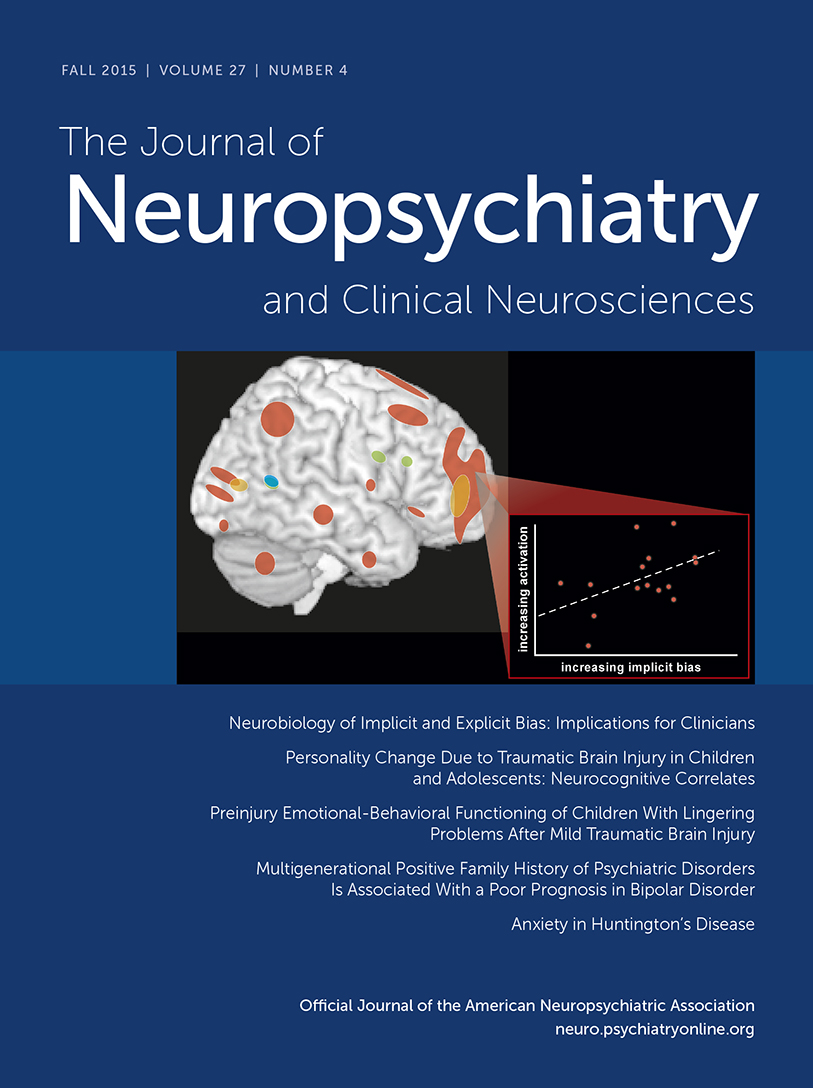From Semantic to Social Deficits: Dysfunction of the Nondominant Posterior Perisylvian Area in Schizophrenia
Abstract
Schizophrenia is characterized by profound deficits in social competence and functioning, independent from active psychotic symptoms at different stages of the disease. Social deficits in schizophrenia are clinically well characterized, but their neurobiological underpinnings are undetermined. This article reviews recent evidence supporting heritable deficits in a circuit necessary for appropriate naming of emotions and mental states in others, centered at the temporoparietal junction of the nondominant hemisphere. The clinical implications of this model are discussed, including the potential use of rehabilitation techniques oriented to recognition and naming of emotions and mental states as a necessary step for social rehabilitation.
Mental health disorders are the main cause of years lived with disability worldwide; among these disorders, schizophrenia accounts for 7.4% of all years lived with disability despite a lifetime prevalence of <1%.1 Loss of social abilities is a hallmark of the disorder, preceding the onset of positive symptoms and persisting after their successful treatment with a variety of available antipsychotic medications; compromised social competence is a major determinant of disability in this disorder.2 Unfortunately, the neurobiological mechanisms of social dysfunction in schizophrenia are largely undetermined, although a combination of neurocognitive and social cognitive deficits is usually considered an important contributing factor. In this review, we summarize evidence by our group and others that social disability in schizophrenia is related to disturbed activity of the right, nondominant hemisphere, resulting in a sensory aphasia specific for emotionally laden nouns and adjectives, which might occur independently from, but could contribute to, general cognition and especially to social cognition. We commence with a description of linguistic functions of the nondominant hemisphere, and we review evidence germane to right hemisphere dysfunction as well as social cognition in schizophrenia. We then describe relevant work that has attempted to characterize neurobiological underpinnings of such abnormalities. We conclude by proposing a hypothesis of nondominant posterior perisylvian area dysfunction in schizophrenia and discussing the clinical implications of such a hypothesis.
Linguistic Functions of the Nondominant Hemisphere
The classic model of language connectivity, formulated in the 19th century but summarized by Geschwind,3 posits that Broca’s area (posterior section of the left inferior frontal gyrus) and Wernicke’s area (posterior middle and superior temporal gyrus, inferior parietal lobule, superior temporal sulcus in the left hemisphere) deal with speech production and comprehension/lexical access, respectively, connected by means of the arcuate fasciculus. Despite its relative simplicity, the model has shown remarkable resilience, probably due in part to its utility in the diagnosis of acquired language disorders.4 More recent models of brain connectivity subserving language in humans postulate the presence of dorsal and ventral “streams” concerned with mapping of speech sounds to motor representation and to meaning, respectively.4,5 However, it remains well recognized that the right hemisphere is not primarily involved with basic levels of language such as phonology, morphology, and syntax.4,5 However, there is consensus based on diverse sources of evidence that the right hemisphere is involved in pragmatic aspects of language that are critical for understanding the speaker’s intention. Thus, lexical semantic processing is currently considered to occur bilaterally.5 Linguistic functions of the right hemisphere have been inferred from both lesion and functional neuroimaging studies and were extensively summarized by Mitchell and Crow6 in their seminal review of this topic. In brief, such abnormalities involve not only prosody (traditionally considered a language function regulated by the right hemisphere) but also comprehension of the main or central theme of discourse, as well as pragmatic aspects of linguistic social communication, including slights, metaphor, humor, and irony. Patients with right hemisphere damage generally understand the literal meaning of utterances well, but comprehension of the main theme of a topic of conversation or reading is usually impaired.7,8 In addition, understanding of metaphors, indirect requests, humor, sarcasm, and irony is almost uniformly impaired in patients with schizophrenia in most studies.9–11 Of note, whereas active psychotic symptoms have been found to have a definite role in deficits in these areas, a significant part of the impairment does not depend on symptoms but is considered to constitute a trait inherent to the disease.12,13
An additional source of evidence underscoring linguistic functions of the nondominant hemisphere comes from patients with “disconnection syndromes,” either with sections or agenesia of the corpus callosum. These studies suggest that left hemispheric structures involved in language comprehension and production necessitate input from the nondominant hemisphere to appropriately and accurately label emotions. In classic studies, commissurotomized patients can show nonverbal indications that they understand emotion but are unable to verbalize these feelings.14 Patients with agenesia of the corpus callosum use less emotional words in the Thematic Apperception Test descriptions.15 Buchanan et al.16 described these patients as having difficulties verbalizing feelings. These findings point to the fact that the right hemisphere must not only be intact for these linguistic functions to be accomplished, but it must also be appropriately connected to structures of the left, dominant hemisphere if the understanding and production of speech conveying emotional meaning are to occur normally (see below).
This and other evidence led to the idea that the left hemisphere has no direct access to the emotional aspects of language, necessitating an intact input from the right hemisphere if emotionally laden words are to be used effectively (reviewed by Shobe17).
Linguistic and Social Cognitive Alterations in Schizophrenia
As summarized by Mitchell and Crow,6 dysfunction of the right hemisphere during the production and interpretation of speech in schizophrenia can also be inferred from a variety of studies. In general, patients with schizophrenia have repeatedly been found to display deficits while understanding others’ speech and producing a coherent discourse, processing meaning alternative to the literal interpretation of speech, and understanding/producing emotional prosody associated with uttered language. Studies documenting these deficits span several decades, and speech abnormalities are in fact considered a core feature of schizophrenia. Bleuler18 described “looseness of associations” in patients with dementia praecox, and this observation has been extensively studied in the following decades. For example, Noël-Jorand et al.19 used computer-assisted discourse analysis to conclude that patients with schizophrenia display a lack of logical cohesion in speech, with use of “language satellites” (i.e., short stretches of speech having no clear relevance to the main topic of conversation). Metaphor comprehension has long been found to be impaired in schizophrenia.20,21 Patients with schizophrenia also fail in the processing of indirect requests, as evidenced by Corcoran et al.22 in the “hinting task.” Humor and sarcasm are also a type of verbal communication that necessitates the evaluation of multiple possible, nonliteral meanings, which is also disrupted in schizophrenia. Corcoran et al.13 suggested that impaired humor comprehension and production in schizophrenia are in turn related to impaired theory of mind abilities, because humor usually requires the observer to discern the character’s true intention in a social situation (see below). In fact, we and others have documented different theory-of-mind deficits in patients with schizophrenia and their unaffected first-degree relatives. Such observations suggest that these deficits are not dependent on active symptoms and might well constitute an endophenotype of this syndrome.23,24
Ross et al.25 and Ross and Monnot 26 demonstrated that linguistic abnormalities in patients with schizophrenia are indistinguishable from those of patients with right hemisphere lesions and are distinct from speech disorders characteristic of a variety of dominant hemisphere lesions. They used an aprosodia paradigm and showed that schizophrenia is characterized by an asymmetric process, whereby language deficits in this disorder are referred to linguistic functions of the right hemisphere. In fact, in the studies by Ross,25,26 patients displayed not only aprosodia (output of nonverbal indications of emotional state) but also deficits in the processing of facial affect, ultimately interfering with interpersonal relations and resulting in social isolation. On the basis of these observations, Ross et al.25 predicted that patients with schizophrenia would display faulty functioning of right posterior perisylvian structures. As reviewed below, our group and others have provided evidence supporting this hypothesis, following observations that schizophrenic patients and at-risk individuals display semantic deficits that are specifically applicable to words denoting emotions and socially salient meaning.
Emotion processing and theory of mind are consistently altered not only in patients with schizophrenia but also in their unaffected first-degree relatives, as extensively documented in the available literature by our group23 and others (Lavoie et al.27 and Martin et al.24 provide recent reviews of available evidence). Emotional processing and theory of mind are usually tested with verbal instruments in which the participant is requested to choose the appropriate word naming an emotion, intention, or mental state, or to interpret the verbal description of a social situation.23 This function can be presumed to depend on intact linguistic functions of the nondominant hemisphere, given the fact that language is an essential part of these tests.
Right Hemispheric Dysfunction During Processing of Social Cognitive Information in Patients With Schizophrenia and At-Risk Subjects
We studied siblings who are discordant for schizophrenia, and we found evidence that supports the predictions by Ross et al.25 regarding dysfunctional right perisylvian structures in schizophrenia. We used a functional MRI paradigm that employed emotion processing and theory-of-mind stimuli in these groups. We found that compared with healthy individuals, siblings who are discordant for schizophrenia display a specific deficit of activation of right hemisphere structures during these paradigms. Figure 1 shows deficits at the temporoparietal junction/superior temporal sulcus, although the inferior and middle frontal gyri were also compromised in the original study.28
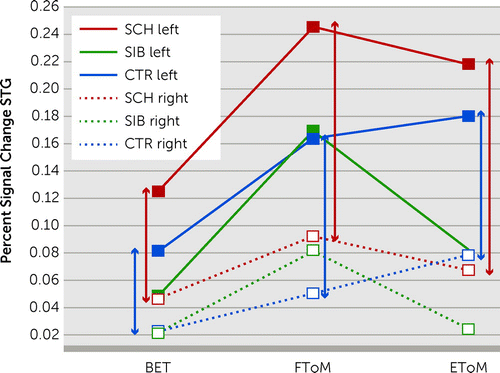
FIGURE 1. Brain Activation in the Superior Temporal Gyri Bilaterally, Induced by Social Cognitive Tasks in Siblings Discordant for Schizophrenia and Healthy Comparison Subjectsa
a Social cognitive tasks tend to evoke a more asymmetrical response (due to lesser right hemisphere activation and greater left hemisphere activation) in patients with schizophrenia (red arrows) compared with healthy controls (blue arrows). Details are available in the text and in our previous work.28 Reproduced from de Achával et al.,28 with permission. BET, basic emotions task; EToM, theory of mind in eyes; FToM, theory of mind in faces; STG, superior temporal gyrus.
Given the fact that unaffected siblings of patients with schizophrenia partially shared the pattern of right hemisphere dysfunction, we sought to determine whether subclinical traits were associated with this finding. Relatives of patients with schizophrenia are known to exhibit an increased risk for personality disorders, classically cluster A (odd, paranoid, eccentric, or autistic behavior), although some epidemiologic studies show an excess prevalence of cluster B personality disorders (attention-seeking behavior, impulsivity, deceitfulness, and even self-directed aggression). We observed that deficit activation of the right temporoparietal junction is related to altered social competence in at-risk individuals with cluster B personality traits (Figure 2).29 This observation provides a parsimonious association of clinical traits with social deficits and a neurobiological signature characteristic of schizophrenia—namely, deficit activation of the right temporoparietal junction.
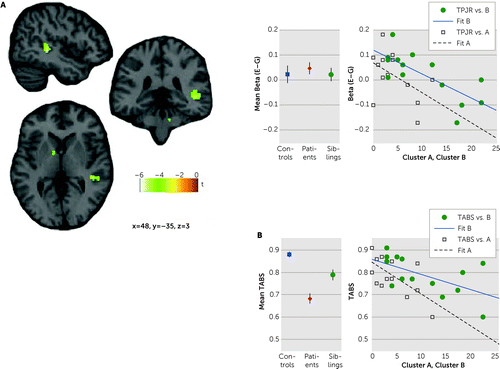
FIGURE 2. Brain Activation Induced by the Basic Emotion Task and Personality Traits in Nonpsychotic Siblings of Patients With Schizophreniaa
a (A) Brain activation correlates with the degree of cluster B symptomatology at the level of the right temporoparietal junction. (B) There is an inverse correlation between cluster B symptom severity and both (a) right temporoparietal junction activity and (b) social competence measured with the Test of Adaptive Behavior in Schizophrenia. Details are available in the text. Reproduced from Goldschimidt et al.,29 with permission. Ctrols, controls; Pat, paternal; Sib, sibling; TABS, Test of Adaptive Behavior in Schizophrenia; TPJR, right temporoparietal junction.
We also attempted to determine whether the observed abnormality in right hemisphere activation induced by social cognitive tasks was relevant to actual social functioning in schizophrenia. For this purpose, we studied social competence tasks in this group. We observed a “right-to-left gradient” in brain activity related to social competence in healthy persons, unaffected siblings, and patients, such that activation of right hemisphere structures correlated with social competence in controls, left hemisphere structures were related to competence in patients, and siblings occupied an intermediate position (Figure 3).30
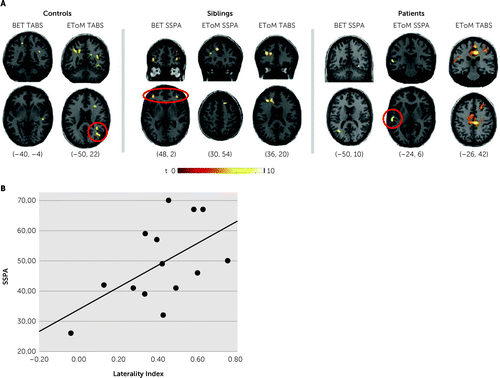
FIGURE 3. Brain Activity Induced by Social Cognitive Tasks Shows a Distinct Correlation With Actual Social Competence in Healthy Controls and Siblings Discordant for Schizophreniaa
a (A) Brain activity induced by social cognitive tasks shows a distinct correlation with actual social competence (measured with the TABS and SSPA tests) in healthy controls and siblings discordant for schizophrenia (red circles). (B) There is a “gradient” of brain activation such that right hemisphere activation correlates with social performance in healthy individuals, left hemisphere activation is related to performance in patients with schizophrenia, and nonpsychotic siblings show areas of correlation on both sides of the brain. In patients with schizophrenia, left lateralization correlates with social competence. Details are available in the text. Reproduced from Villarreal et al.,30 with permission. BET, basic emotions task; EToM, theory of mind in eyes; SSPA, Social Skills Performance Assessment; TABS, Test of Adaptive Behavior in Schizophrenia.
Semantic Aphasia for Mental and Emotional States in Schizophrenia Is Due to Dysfunction of a Complex Circuit Centered at the Right Temporoparietal Junction
On the basis of these observations, we propose that social deficits in schizophrenia are the manifestation of deficits in linguistic functions of the right, nondominant hemisphere—specifically, in the form of a sensory or comprehension aphasia that originates in faulty function of right posterior perisylvian structures traditionally associated with theory of mind, affecting speech output through extensive connections with Wernicke’s area in the left hemisphere. Wible31,32 extensively reviewed the role of the right temporoparietal junction. Whereas implicit recognition of the emotion and intention experienced by another member of the group relies on motor and limbic activity in other species, language is probably the “final common pathway” for theory of mind and empathy in humans. Ultimately, the capacity for precise recognition of what another member of the group is feeling or thinking depends on being able to produce the word that most accurately describes such a state. The right temporoparietal junction and right superior temporal sulcus are the contralateral homologue areas of Wernicke’s area of the dominant hemisphere, and they display extensive connections with the latter through fibers that cross the corpus callosum33 and are anatomically located in the tapetum. It is not surprising that the temporoparietal junction is involved in an integrative function such as theory of mind, because it is a true anatomical “crossroad” linking areas in all cerebral lobes. In addition to the tapetum and arcuate fasciculus, white matter tracts underlying the temporoparietal junction area include the horizontal portion of the superior longitudinal fasciculus, the middle longitudinal fasciculus, the inferior longitudinal fasciculus, the inferior fronto-occipital fasciculus, and optic radiations; hence, the known clinical finding of the temporoparietal junction is known as one of the most “eloquent” areas of the human brain in neurosurgical studies.33
In relationship to its anatomical position, the temporoparietal junction/superior temporal sulcus integrates motor information about others’ gaze and arm movements, possibly subserving intention detection in other members of the species.34,35 This is likely accomplished by comparing one’s own intentions, as inferred from motor behavior, with the intention of others (i.e., regions used to represent the self overlap with those used to represent others).36–38 Presumably, activity in this area in humans informs its analogue in the dominant hemisphere (i.e., Wernicke’s area) to allow identification of the right word to describe the other person’s mental state.34,35 Whereas most data point to dysfunction of the right posterior perisylvian area during cognitive tasks in patients with schizophrenia and in individuals at genetic risk, it is not possible to rule out that the latter is primarily due to frontal/motor alterations in the same hemisphere or to a more general brain lateralization abnormality (see below).28
In this view, appropriate social functioning ultimately depends on an adequate recognition of emotions and intentions in other members of the species, which manifests with the precise naming of such mental states in humans (Figure 4). The naming process begins with identification of facial expression, which is a particular case of motor behavior. Presumably, such identification depends on intact bilateral mirror neuron systems located in prefrontal areas, especially the inferior frontal gyri and operculum. Motor information should then reach the right temporoparietal junction, which is identified as a critical node for theory of mind. Indeed, the right temporoparietal junction is the homologue of Wernicke’s area in the nondominant hemisphere, informing the latter through extensive callosal connections across hemispheres. Only then can the appropriate noun or adjective designating an emotion or mental state be chosen. In experimental paradigms, the appropriate concept is uttered after Broca’s area receives this information through the arcuate fasciculus. In day-to-day social interactions, the word is not pronounced but still informs the person about the other subject’s intentions or emotional state, permitting the planning and elaboration of the context-appropriate social behavior. As predicted by Ross et al.,25 in this scheme, schizophrenia would be characterized by failed social responses that originated in faulty identification of mental states in others due to nondominant hemisphere deficits specifically involving posterior perisylvian areas (Figure 4). This model would extend Crow’s6 proposal of abnormal brain lateralization resulting in symptoms that are originated in nondominant hemisphere linguistic functions (namely, positive symptoms, including Schneiderian first-rank symptoms, and symptoms considered as “negative,” especially flatness of affect and social isolation).
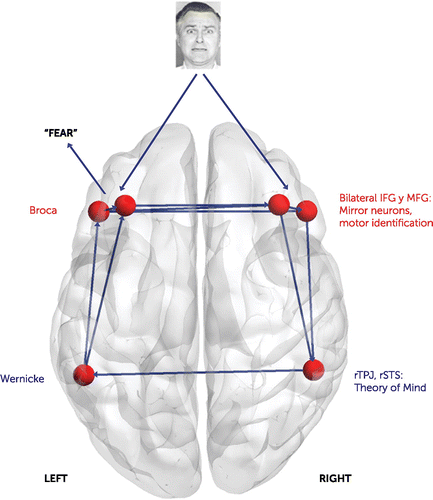
FIGURE 4. Model of Semantic Deficits for Naming of Emotions and Mental States in Schizophreniaa
a Naming fails when left hemisphere language structures do not receive appropriate input from the right temporoparietal junction, leading to faulty recognition of emotions and theory of mind. Ventral/dorsal streams of speech processing in the dominant hemisphere and anatomical right frontal to left occipital brain “torque” are not shown. Details are available in the text. IFG, inferior frontal gyrus; MFG, middle frontal gyrus; rSTS, right superior temporal sulcus; rTPJ, right temporoparietal junction.
Abnormal Brain Lateralization and Predisposition to Schizophrenia
Abnormal brain lateralization in schizophrenia has been extensively addressed in the literature,6,39 and most structural and functional findings in persons with schizophrenia and predisposed subjects are indeed lateralized. A recent meta-analysis of combined structural and functional MRI studies in persons with an increased genetic risk for schizophrenia detected a series of lateralized abnormalities, including functional alterations in the right anterior and posterior temporal gyri.40 Recent preliminary findings by our group in a regional sample detected increased cortical thickness in the right supramarginal gyrus in patients and unaffected siblings,41 in the vicinity of the right temporoparietal junction/superior temporal sulcus. The question arises regarding the mechanisms of abnormal brain lateralization in schizophrenia, which in turn is related to social disability. Recent research on the genetic basis of the psychoses42,43 maintains that predisposition to schizophrenia is highly polygenic (likely involving single nucleotide polymorphisms in thousands of genes, each with a very small individual effect) and is highly prevalent in the general population. It is interesting to note that few genes have been observed to show a lateral bias in brain tissue expression.44 Therefore, aspects of the disease that are highly relevant to the deficits seen in this disorder might be accounted for by the single genetic variable of laterality/asymmetry,45 which acquires paramount importance in language development. In this regard, it is interesting that schizophrenia differentially affects males and females; there are data that primate brain lateralization is gender specific, as evidenced by the homology of X- and Y-linked protocadherins (PCDHX and PCDHY, respectively).45–47 Inherited developmental deficits in areas of the nondominant hemisphere involved in language would thus have a significant explanatory value for symptoms of schizophrenia in the preclinical and premorbid phases, including social adjustment deficits.48,49
Clinical Implications
Attempts at ameliorating functional outcomes in schizophrenia have had limited success. Apart from administering standard pharmacologic interventions (e.g., antipsychotics and, when indicated, antidepressants) and intervening with the patients’ families to reduce levels of expressed emotion,50,51 current efforts aim to remediate cognitive deficits and further ameliorate positive symptoms with the help of cognitive-behavioral interventions. In this regard, it is worth considering rehabilitation techniques used with patients who have sustained right hemisphere lesions of a different nature, including those with traumatic brain injury. Recent attempts have been made at rehabilitating verbal communication deficits in these patients.52–56 Such efforts are mostly addressed at ameliorating the aprosodia resulting from these lesions57 as well as improving conversational capacity and knowledge of social rules, both of which are impaired in patients with right hemispheric lesions.55,56,58 To our knowledge, no studies have aimed to improve identification and naming of emotional and mental states in other persons. On the basis of the evidence reviewed herein, we suggest that language rehabilitation should also be included and should specifically address improving the preciseness of the patients’ lexicon to name emotion and mental states in others by means of specific training. This training would focus on pragmatic aspects of verbal communication, possibly with correct semantic identification of emotions and intentions in faces and social situations, and this effort would include ecological training on the detection of irony and prosody during social interactions. Although our proposal is speculative at this time, it might be worth exploring as an addition to developing techniques of social rehabilitation in patients with schizophrenia.
1 : Global burden of disease attributable to mental and substance use disorders: findings from the Global Burden of Disease Study 2010. Lancet 2013; 382:1575–1586Crossref, Medline, Google Scholar
2 : Functional impairment in people with schizophrenia: focus on employability and eligibility for disability compensation. Schizophr Res 2012; 140:1–8Crossref, Medline, Google Scholar
3 : The organization of language and the brain. Science 1970; 170:940–944Crossref, Medline, Google Scholar
4 : The language connectome: new pathways, new concepts. Neuroscientist 2014; 20:453–467Crossref, Medline, Google Scholar
5 : The maps problem and the mapping problem: two challenges for a cognitive neuroscience of speech and language. Cogn Neuropsychol 2012; 29:34–55Crossref, Medline, Google Scholar
6 : Right hemisphere language functions and schizophrenia: the forgotten hemisphere? Brain 2005; 128:963–978Crossref, Medline, Google Scholar
7 : Discourse deficits, in Right Hemisphere Damage. San Diego, Singular Publishing Group, 1999, pp 101–134Google Scholar
8 : [The impact of lesions in the right hemisphere on linguistic skills: theoretical and clinical perspectives]. Rev Neurol 2008; 46:481–488 (Spanish)Medline, Google Scholar
9 : The comprehension of metaphor in brain-damaged patients. Brain 1977; 100:717–729Crossref, Medline, Google Scholar
10 : Contextual and thematic influences on narrative comprehension of left and right hemisphere brain damaged patients, in Narrative Discourse in Neurologically Impaired and Normal Aging Adults. Edited by Brownell HH, Joanette Y. San Diego, Singular Publishing Group, 1993, pp 213–238Google Scholar
11 : Hemispheric asymmetries in the resolution of lexical ambiguity. Neuropsychologia 2000; 38:272–282Crossref, Medline, Google Scholar
12 : Schizophrenics’ and college students’ preference for and judgment of schizophrenic versus normal humorous captions. J Psychol 1984; 118:189–195Crossref, Medline, Google Scholar
13 : The appreciation of visual jokes in people with schizophrenia: a study of ‘mentalizing’ ability. Schizophr Res 1997; 24:319–327Crossref, Medline, Google Scholar
14 : Self recognition and social awareness in the deconnected minor hemisphere. Neuropsychologia 1979; 17:153–166Crossref, Medline, Google Scholar
15 : Social narratives in agenesis of the corpus callosum: linguistic analysis of the Thematic Apperception Test. Neuropsychologia 2010; 48:43–50Crossref, Medline, Google Scholar
16 : A proposed neurophysiological basis of alexithymia. Psychother Psychosom 1980; 34:248–255Crossref, Medline, Google Scholar
17 : Independent and collaborative contributions of the cerebral hemispheres to emotional processing. Front Hum Neurosci 2014; 8:230Crossref, Medline, Google Scholar
18 : Dementia Praecox or the Group of Schizophrenias (1911). Translated by Zinkin J. New York, International Universities Press, 1950Google Scholar
19 : A new approach to discourse analysis in psychiatry, applied to a schizophrenic patient’s speech. Schizophr Res 1997; 25:183–198Crossref, Medline, Google Scholar
20 : Language and Thought in Schizophrenia. Berkeley, CA, University of California Press, 1944Google Scholar
21 : Understanding minds and understanding communicated meanings in schizophrenia. Mind Lang 2002; 17:68–104Crossref, Google Scholar
22 : Schizophrenia, symptomatology and social inference: investigating “theory of mind” in people with schizophrenia. Schizophr Res 1995; 17:5–13Crossref, Medline, Google Scholar
23 : Emotion processing and theory of mind in schizophrenia patients and their unaffected first-degree relatives. Neuropsychologia 2010; 48:1209–1215Crossref, Medline, Google Scholar
24 : Theory of mind and the social brain: implications for understanding the genetic basis of schizophrenia. Genes Brain Behav 2014; 13:104–117Crossref, Medline, Google Scholar
25 : Affective-prosodic deficits in schizophrenia: comparison to patients with brain damage and relation to schizophrenic symptoms [corrected]. J Neurol Neurosurg Psychiatry 2001; 70:597–604Crossref, Medline, Google Scholar
26 : Affective prosody: what do comprehension errors tell us about hemispheric lateralization of emotions, sex and aging effects, and the role of cognitive appraisal. Neuropsychologia 2011; 49:866–877Crossref, Medline, Google Scholar
27 : Social cognition in first-degree relatives of people with schizophrenia: a meta-analysis. Psychiatry Res 2013; 209:129–135Crossref, Medline, Google Scholar
28 : Decreased activity in right-hemisphere structures involved in social cognition in siblings discordant for schizophrenia. Schizophr Res 2012; 134:171–179Crossref, Medline, Google Scholar
29 : Cluster B personality symptoms in persons at genetic risk for schizophrenia are associated with social competence and activation of the right temporo-parietal junction during emotion processing. Psychiatry Res 2014; 221:30–36Crossref, Medline, Google Scholar
30 : Pattern of brain activation during social cognitive tasks is related to social competence in siblings discordant for schizophrenia. J Psychiatr Res 2014; 56:120–129Crossref, Medline, Google Scholar
31 : Hippocampal temporal-parietal junction interaction in the production of psychotic symptoms: a framework for understanding the schizophrenic syndrome. Front Hum Neurosci 2012; 6:180Crossref, Medline, Google Scholar
32 : Schizophrenia as a disorder of social communication. Schizophr Res Treatment 2012; 2012:920485Crossref, Medline, Google Scholar
33 : Fiber dissection and diffusion tensor imaging tractography study of the temporoparietal fiber intersection area. Neurosurgery 2013; 72(Suppl Operative):87–97, discussion 97–98Crossref, Medline, Google Scholar
34 : Electrophysiology and brain imaging of biological motion. Philos Trans R Soc Lond B Biol Sci 2003; 358:435–445Crossref, Medline, Google Scholar
35 : Perceiving fear in dynamic body expressions. Neuroimage 2007; 35:959–967Crossref, Medline, Google Scholar
36 : The out-of-body experience: disturbed self-processing at the temporo-parietal junction. Neuroscientist 2005; 11:16–24Crossref, Medline, Google Scholar
37 : Live face-to-face interaction during fMRI: a new tool for social cognitive neuroscience. Neuroimage 2010; 50:1639–1647Crossref, Medline, Google Scholar
38 : My body in the brain: a neurocognitive model of body-ownership. Neuropsychologia 2010; 48:703–712Crossref, Medline, Google Scholar
39 : Three-dimensional mapping of gyral shape and cortical surface asymmetries in schizophrenia: gender effects. Am J Psychiatry 2001; 158:244–255Crossref, Medline, Google Scholar
40 : Multimodal voxel-based meta-analysis of structural and functional magnetic resonance imaging studies in those at elevated genetic risk of developing schizophrenia. Psychiatry Res 2014; 221:69–77Crossref, Medline, Google Scholar
41 : Voxel-based morphometry analysis of grey matter abnormalities in a regional sample of siblings discordant for schizophrenia, in Proceedings of the Second Schizophrenia International Research Society South America Meeting. Buenos Aires, University of Buenos Aires School of Medicine, 2014Google Scholar
42 : Common polygenic variation contributes to risk of schizophrenia and bipolar disorder. Nature 2009; 460:748–752Crossref, Medline, Google Scholar
43
44 : Temporal specification and bilaterality of human neocortical topographic gene expression. Neuron 2014; 81:321–332Crossref, Medline, Google Scholar
45 : The protocadherin 11X/Y (PCDH11X/Y) gene pair as determinant of cerebral asymmetry in modern Homo sapiens. Ann N Y Acad Sci 2013; 1288:36–47Crossref, Medline, Google Scholar
46 : Sex differences in the cerebral organization of verbal functions in patients with unilateral brain lesions. Brain 1977; 100:775–793Crossref, Medline, Google Scholar
47 : Sex differences in molecular neuroscience: from fruit flies to humans. Nat Rev Neurosci 2010; 11:9–17Crossref, Medline, Google Scholar
48 : Association between functioning in adolescence prior to first admission for schizophrenia and affective disorders and patterns of hospitalizations thereafter. Schizophr Res 2005; 73:185–191Crossref, Medline, Google Scholar
49 : Population-based cohort studies on premorbid cognitive function in schizophrenia. Epidemiol Rev 2008; 30:77–83Crossref, Medline, Google Scholar
50 : The influence of family and social factors on the course of psychiatric illness. A comparison of schizophrenic and depressed neurotic patients. Br J Psychiatry 1976; 129:125–137Crossref, Medline, Google Scholar
51 : Negative communication in psychosis: understanding pathways to poorer patient outcomes. J Nerv Ment Dis 2014; 202:829–832Crossref, Medline, Google Scholar
52 : Perspectives on treatment for communication deficits associated with right hemisphere brain damage. Am J Speech Lang Pathol 2007; 16:331–342Crossref, Medline, Google Scholar
53 : Clinical focus on prosodic, discursive and pragmatic treatment for right hemisphere damaged adults: what’s right? Rehabil Res Pract 2011; 2011:131820Medline, Google Scholar
54 : Social communication interventions for persons with traumatic brain injury, in Rehabilitation Interventions Following Traumatic Brain Injury: State of the Science. Edited by High WM Jr, Sander AM, Struchen MA, Hart KA. New York, Oxford University Press, 2005, pp 88–117Google Scholar
55 : Social communication skills group treatment: a feasibility study for persons with traumatic brain injury and comorbid conditions. Brain Inj 2010; 24:1298–1310Crossref, Medline, Google Scholar
56 : Treatment efficacy of social communication skills training after traumatic brain injury: a randomized treatment and deferred treatment controlled trial. Arch Phys Med Rehabil 2007; 88:1561–1573Crossref, Medline, Google Scholar
57 : Active treatments for aprosodia secondary to right hemisphere stroke. J Rehabil Res Dev 2005; 42:93–101Medline, Google Scholar
58 : Évaluation d’un programme d’intervention visant les habiletés pragmatiques chez un individu cérébrolésé droit. Maîtrise Professionnelle en Orthophonie. Montreal, Université de Montréal, 2003Google Scholar


